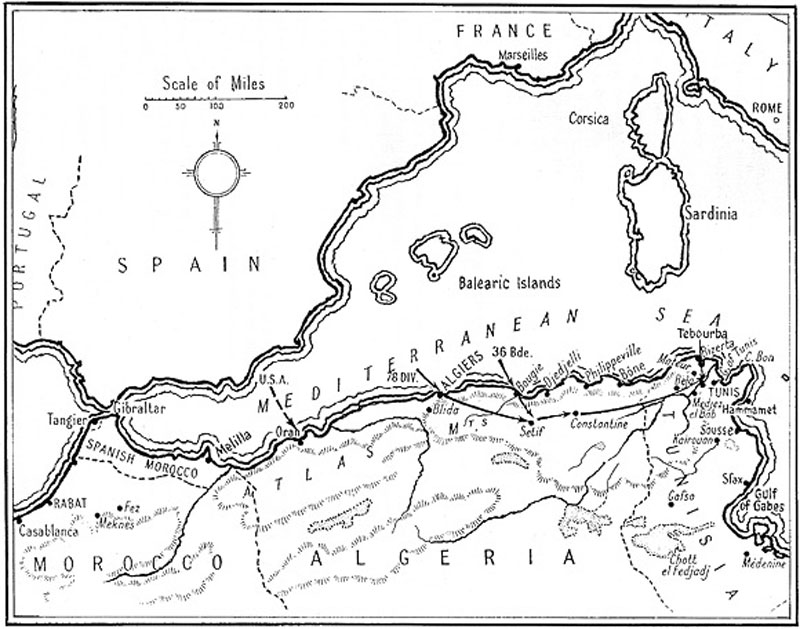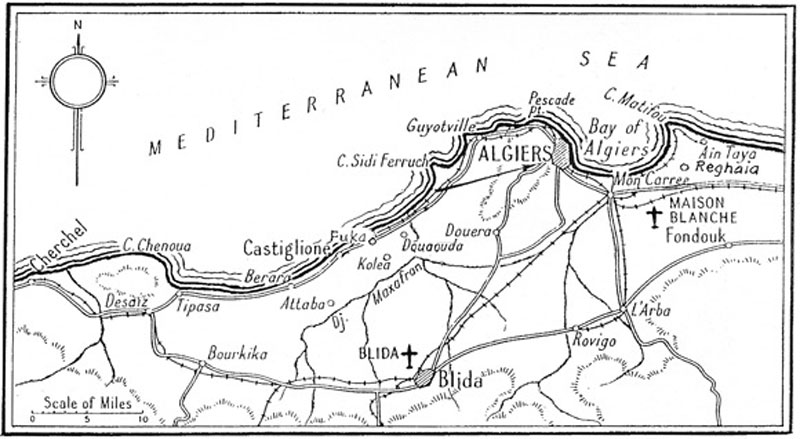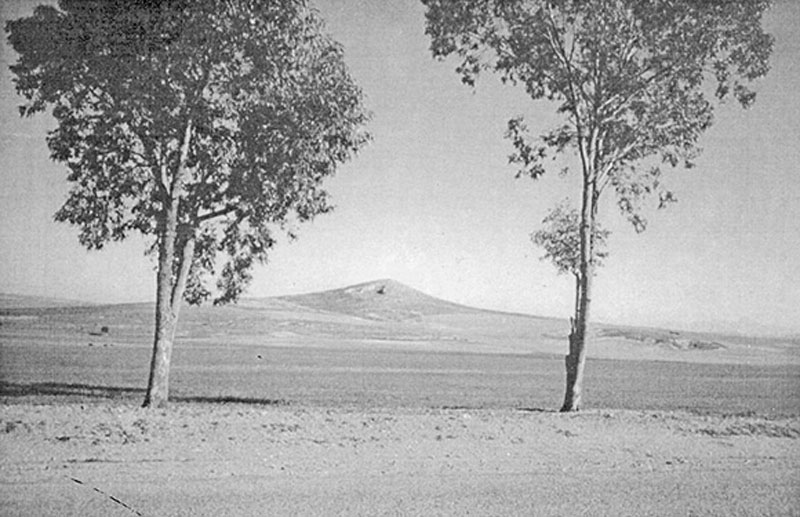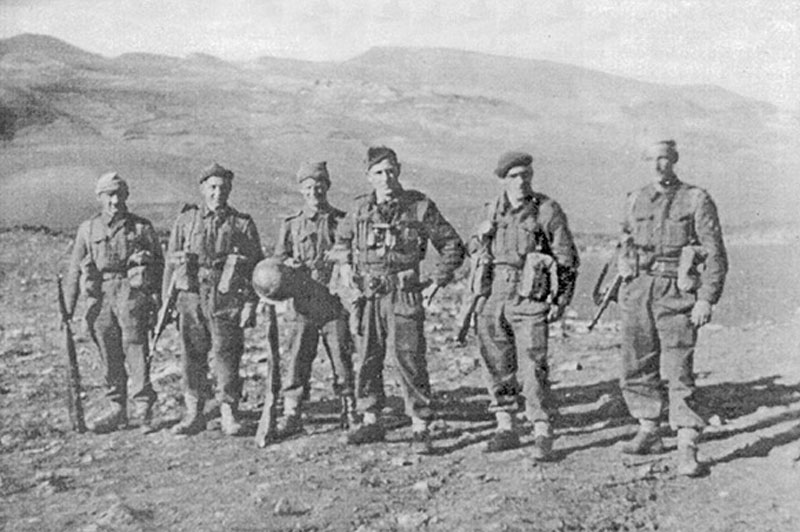1st Battalion
Winter and German Counter-offensive
Chapter 5
While in its positions near Oued Zarga, the Battalion received its first reinforcements and set about reorganising and re-equipping itself. Here a great deal of patrolling was carried out, not only to locate the enemy, but to deal with the bands of Arabs who roved the countryside, raiding farms and taking advantage generally of the conditions of war.
On 10th December the Battalion moved by motor transport to Hunt's Gap where it took up defensive positions. Hunt's Gap was a valley named after the Commanding Officer of 49 Light Anti-Aircraft Regiment, of 78 Division who had reconnoitred it. The valley was a tank approach from the north through Sidi N'sir to Beja and Oued Zarga.
By the middle of December the Allied thrust on Tunis had been halted. First Army could not get beyond Medjez in the south or Mateur in the north where 36 Brigade had been brought to a stop.
|
Map 1 |
Map 2 |
Preparations were now made for another attempt to reach Tunis, with 11 Brigade in the lead and 1 Surreys leading the Brigade. The Battalion spent a couple of days in pouring rain awaiting the order to advance, which could not be given until Longstop Hill had been recaptured. 1 Guards Brigade, which had landed towards the end of November, was given this task and fighting magnificently against desperate opposition, they drove off the enemy and occupied the hill. But the rain was so heavy that all tracks were turned to mud and wheeled vehicles immobilised. As a result 1 Guards Brigade was withdrawn from Longstop Hill and on Christmas Day the whole operation was cancelled. In the calling off of the advance all hopes of capturing Tunis before the spring were abandoned and therefore defensive positions were taken up while additional troops were joining First Army. Winter with its rain and mud had brought about a condition of stalemate.
1 Surreys now marched back to Oued Zarga where they dug in on the escarpment overlooking the village and one company was in position on the high ground above the Arab village of Toukabeur. This position formed a flank guard or western outpost to the Medjez defences. The weather was atrocious and the ;Battalion had a very wet and uncomfortable Christmas. The enemy pushed forward from Tebourba, seized Longstop Hill and gradually invested the Medjez perimeter which became an exposed salient overlooked by high ground on three sides. Christmas Day was particularly disturbed for C Company (Captain W D Caffyn). The Northamptons had been sent across country to try to turn the Longstop Hill position from the north and had got lost in the hills. C Company was sent forward across the hills to Heidous to form a firm base for the Northamptons to pass through on their withdrawal. The company in slogging through thick mud became heavily engaged with the enemy who were following up the Northamptons, and then it was the turn of the Northamptons in the hills around Toukabeur to give cover to C Company. Thanks to their help and particularly to timely covering fire from a French Algerian battalion, C Company got back through the Northamptons.
Early in January 1943 the Battalion moved by motor transport from the Oued Zarga Hills northwards to Sidi N'sir, where it spent several weeks in widely dispersed company positions centered around the railway station. The road and railway from Beja to Mateur ran through the valley (Hunt's Gap) and at Sidi N'sir the valley was about three quarters of a mile in width with rocky mountains on either side. D Company (Captain J F V Brooke Fox) was forward on the left hand side of the valley and B Company (Captain R C Taylor) on the right. Both managed to find Arab dwellings which were used as Company Headquarters. B Company's was a hut with only a flimsy wall separating it from the village headman. The Battalion was 6 or 7 miles forward of Brigade Headquarters and often enemy patrols would cut the road behind Battalion Headquarters by laying mines at night.
While at Sidi N'sir many of those wounded at Tebourba rejoined the Battalion from hospital. Among them were two company commanders, Captain Andrews (A) and Major Buchanan (B).
About 4 miles further north the Germans held the railway station at Mettrahenie. The area between the enemy and the Battalion became an arena for long distance and intensive patrolling. There were several patrol clashes and during one on 16th January a patrol, led by Lieut J F Louis, encountered an enemy patrol about 30 in strength and went to ground. Lieut Louis, known as 'Chips', was a tough New Zealander, aged 37, who claimed he was the oldest platoon commander on active service. The enemy patrol passed by but three Germans lagged behind and Chips and his men grabbed them silently without the enemy realising what had happened. Among the three prisoners was a warrant officer. The patrol was congratulated by the Divisional Commander, Major-General V Evelegh, CB.,CBE., but his staff were a little put out to find the prisoners on arrival at Divisional Headquarters still carrying their grenades!
On 31st January 1943 the Battalion was ordered to carry out weapon training wearing gas masks. The practice lasted about ten minutes and obviously alerted the enemy. Half an hour after the firing had ceased, a report was received from Brigade Headquarters that a black box was on the railway line in front of B Company's position. Major Buchanan was ordered to send out a strong patrol to collect the black box. The Company was put on the alert and a patrol under Lieut G M Everitt, accompanied by a Sapper officer, went out. Unfortunately, a strong enemy force was in the vicinity and ambushed Lieut Everitt's patrol. A brisk fight ensued but the whole of the patrol was captured and the black box was never recovered.
On 1st February, 1 Surreys was relieved at Sidi N'sir by 1/4 Hampshires of 46 Division recently out from the United Kingdom. From Sidi N'sir the Battalion moved south in motor transport led by the carriers. On the journey south the leading carrier struck a mine on the road and overturned. The mine must have been laid during the night after the passage north of the relieving battalion. Two members of the crew of the carrier were thrown clear but the third member was trapped. The column was held up while mine clearing was carried out, and several mines made harmless. The carrier was raised to release the trapped man who had remained conscious throughout and had shown considerable pluck and fortitude. Sadly he had suffered internal injuries and died three weeks later in hospital.
After two days back in the Hunt's Gap sector the Battalion moved to the Mortar Hill area. While here Major T A Buchanan, MC., who had served with the Battalion since the campaign in France in 1940, left on appointment as second-in-command of 5 Northamptons. On 13th February, 1 Surreys moved south over the River Medjerda via a newly constructed Bailey bridge to relieve an American unit near Goubellat.
In the new positions companies were more widely dispersed than ever before. The Battalion covered approximately seven miles of front, D Company (Major J F V Brooke Fox) was well forward in the Goubellat Plain, about one and a half miles in front of the Battalion's main position, on an isolated hill named by the Americans as 'Fort MacGregor'. B Company (Captain R C Taylor) was behind in the main position with C Company (Captain W D Caffyn) on its left and A Company (Captain RAN Andrews) on its right.
Fort MacGregor has been described by Lieut R F Kinden, a platoon commander in D Company, as 'a triangular shaped rocky knoll covering an area a little larger than a football pitch in an isolated position on Goubellat Plain'. The immediate task was to improve the defences by digging and wiring. Much patrolling was carried out on the Plain especially around Fort MacGregor. A fighting patrol was carried out by C Company which set out at 2000 hours on 22nd February and after being ambushed by a strong enemy patrol returned to its positions at 0505 hours on 23rd February. Captain W D Caffyn, Lieut Mervyn Lamb, CSM R J Spencer and 28 Other Ranks of the company reported back. Ten men of the company were wounded and six missing. CSM Spencer was subsequently awarded the Military Medal for his courageous conduct on the patrol.
During the night of 25th February, Lieut Kinden took out a reconnaissance patrol which lost one man killed before returning to Fort MacGregor at about 2330 hours. He reported to Major Brooke Fox, the company commander, that there was evidence of strong enemy forces in the immediate area. Soon after, a heavy bombardment was launched against Fort MacGregor, followed by an infantry attack. The assault, made by paratroopers of the Herman Goering Division, was beaten off. The enemy pulled back, but not for long.
At this time Major Brooke Fox reported by field telephone to Battalion Headquarters that his second-in-command, Captain R A Lindsay, had been killed as well as many others, but he sounded confident that his company could hold its position. Soon after this conversation the line went dead.
Lieut Kinden has described the subsequent events of the night: "I returned to No 17 Platoon and had a word with Sergeant Bob Finnis about the patrol when almost at once the whole hill lit up with machine-gun tracer, flares, and heavy mortar bombardment. Almost as soon as the bombardment stopped an infantry assault was made on all platoon positions by German paratroopers. The attack was beaten off. The enemy was stopped at the outer wire by steady, accurate and controlled fire, and suffered heavy casualties. The enemy pulled back and there was a lull".
"A second attack started after a heavier bombardment. This was a much stronger assault. 16 Platoon was wiped out and the enemy gained a foothold in 18 Platoon's positions and in my own platoon area. The battle was at its height, intense, bloody and desperate. We fell back to our rear weapon pits and fought on from there. The enemy pressure now eased off but about ten minutes afterwards, without any pre-bombardment or warning, the paratroopers mounted their third and final attack. I heard our Medium Machine-gun cease firing and almost at once saw a solid wave of paratroopers coming in directly at the remains of my platoon. Many enemy were cut down by our intense fire just yards from our last two manned weapon pits, but there was no stopping this overwhelming attack". Lieut Kinden was wounded and taken prisoner, another platoon commander, Lieut D Rook, was also taken prisoner.
At 0700 hours on 26th February B Company (Captain R C Taylor) was ordered to make a counter-attack on Fort MacGregor. Ten minutes after the order was received the counter-attack was under way, but when No 10 Platoon (Lieut J F Louis) had got well out towards Fort MacGregor the attack was cancelled. In the short time there had been several casualties, including Sergeant L Collins who was killed and Lieut Louis who was wounded in the leg. A section of carriers under Sergeant J Davies, which had been forward on Goubellat Plain since first light, came back, bringing with them a few survivors from D Company whom they had rescued from the Germans. These men reported that D Company had fought on until being overwhelmed by sheer weight of numbers. In the battle for Fort MacGregor the gallant company commander, his second-in-command and many of his men were killed as well as others wounded and captured. This loss was a severe blow to the Battalion.
During the Fort MacGregor battle, the enemy captured Djebel Djaffa from a battalion of French Colonial troops. This was a prominent feature on the right flank of the Battalion and its capture meant that 11 Brigade Headquarters and the gun lines immediately behind were exposed. Orders were given for Major H B L Smith with A Company and a detachment of 3-inch mortars under Sergeant T W Straight to recapture Djebel Djaffa. The counter-attack was most successful. Lieut E H Giles's platoon carried out a flanking attack, covered by the rest of A Company, and captured 25 prisoners. The force, now augmented by a troop of Valentine tanks and later by a company of 2 Lancashire Fusiliers, went in with great dash and cleared the hill. The position was held until it was taken over by its original French defenders. For his leadership in this action Lieut Giles was awarded the Military Cross.
After the successful action by Major Smith at Djebel Djaffa the whole of the Divisional Artillery plus a medium regiment and a battery of heavy artillery pounded Fort MacGregor. At 2200 hours that night 26th February, a reconnaissance patrolled by Lieut J M Woodhouse was sent to Fort MacGregor where they found that the heavy shelling had done its job. The hill was a ghastly sight - a mass of twisted and blasted corpses, both British and German, which had been pounded by the continual shelling. The patrol captured six enemy. The Padre (the Reverend Gough Cooper) buried over sixty dead from an area no bigger than a football pitch. Fort MacGregor was subsequently occupied by 11 Platoon (Lieut J A H Saunders) of B Company.
|
Fort MacGregor from main Battalion positions |
Lieut J F Louis and B Company Patrol at Sidi N' sir |
In the History of The East Surrey Regiment it is recorded 'The fighting of D Company at Fort MacGregor on 26th February 1943 was as heroic as any incident in the long history of the Regiment' .
Sergeant J Davies was awarded the Military Medal for his leadership of the carriers, and Private R H Moore, the Distinguished Conduct Medal for exceptional gallantry. Not only did he stalk a German sniper and kill him, but he displayed great coolness in carrying messages and tending the wounded under fire.
The 3rd March saw the end of the German offensive to break the First Army's hold in Tunisia. The Allied line was changed but Medjez was still held. The failure of the German attacks marked the end of the first phase of the campaign. The Battalion remained in its positions near Goubellat until the end of March when it took over Djebel Djaffa from the French. Early in April, 1 Surreys took over positions in the Medjez Garrison but were soon withdrawn to a concentration area in preparation for the Spring offensive.
Related




